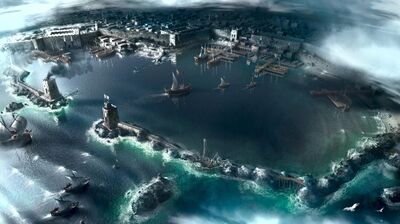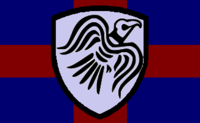Jorvik
| Jarldom of Jorvik | |
| Subdivision type: | Canton of Norsmandy |
| Capital: | Jorvik |
| Population: | 2,841,006 |
| Largest Cities: | Jorvik |
|
| |
| Local Leadership Title: | Jarl |
| Local Government: | Jarl's Council |
| Current leader: | Grothgar Gwynned |
|
| |
| Local language: | Lac Glaceian (official), Anglo-Saksen, Storish |
| Local Religion: | The Alpine Temple |
Jorvik, also known as the Royal City of Jorvik (Arminian: Ȝorvik, or Ȝorwich), is a city in Lac Glacei which is situated on the continent Apollonia in the former cardinal direction of the Jewel of Many Facets which was known as Angsax Ingetheod Cynwise. It was the capital of the Royal Precinct of the Elwynnese Union called the Jarlorð of Jorvik as well as of the Bailiwick of the same name.
About

Jorvik is an ancient walled city which is situated at the confluence of the rivers Hvítá and Trysilelva. Its location provides innumerable opportunities for trade with its vast hinterland and has allowed it to become the Jarlorð of Jorvik's primary trade port.
The city is clean and well-ordered, with wide straight cobbled streets that make it easy to move around. Marble maidens light the way along the streets of Jorvik, bowls of burning sweet-scented oil cradled in their arms. The houses in Jorvik are built of whitewashed stone, often with timber-framing, and steeply-pitched roofs of dark grey slate. It is rich in ancient history, and is renowned for its romantic ambience and numerous possiblities for fun activities.
Outskirts
- Sælerklippe is a massive stone dominating the approaches to the outer harbour. It is crowned with a ringfort of weathered stones of the Angsax that stood desolate and abandoned for centuries. However, in the 1630s it was fortified it with snipers, machine guns, and artillery. The stone looms a hundred feet above the waters, grey-green in color. Seals often rest on it.
- The Quays of Wray the name of Jorvik's harbour. It is divided into an inner and and outer harbour. The outer harbour is larger, but the inner harbour offers better anchorage and shelter by the city wall on one side and the looming mass of Tidewater Keep on another. A ten miles-long, thirty foot wall, with towers every hundred yards, is located on the jetty that separates the two harbours.
- Tidewater Keep is an ancient Angsaxon fortress which nowadays serves as a museum. It is situated by the water and adjoins the city walls. Houses cling like barnacles to the walls of Tidewater Keep; one is a brewhouse is called Cadleigh House which makes well-regarded golden mead. There is a Godsgrove featuring statues of the Storlafðir within the museum's walls.
- Myth Mercat is Jorvik's largest fishmarket. It is named after the tall tales told by the fishermen. The market is located between the outer harbour and the Seolh Gate. Seafood available in Jorvik include whitefish, winkles, crabs, mussels, clams, herring, cod, salmon, lobster, and lampreys.
- Turnip Square is one of Jorvik's oldest and largest market squares. around it lies a maze of twisting alleys and cross streets.
Inside the walls
- The city is protected by thick walls. The Seolh Gate opens into the harbour.
- Jarl's Yard, is a cobbled square with a fountain at its center, located just outside the Seolh Gate. There is an alley leading to a tavern.
- The Old Mint, a royal mint located in Jarl's Yard.
- The Wanton Whale, a sleazy bar frequented by louche businessmen and other folks who are up to no good. It is notorious for offering the oldest, ugliest whores and the vilest drinks in Jorvik, along with foodstuffs that are inedible on their best days and poisonous on their worst.
- The Stepstones is a street with steps. It is a broad white stone way that leads up from Tidewater Keep by the water to the Seaquen on its crag. From the top there is a view down to both harbours.
- The Tributary Temple is a large temple with a domed roof surmounted by tall statues of several Vanic Deities, including Freyja and Elwynn.
Seaquen
- The Seaquen was the seat of the Jarl and Grand Elector of Jorvik. It is located on a crag inside the city wall, the broad white stone way of Stepstones leads to its gates from Tidewater Keep below. There is a secret passage beneath the Stepstones connecting it to the Tidewater Keep.
- Grand Elector's Court is the great hall of the Seaquen where the Jarl and Grand Elector of Jorvik held court and feasts. Its walls, floor and ceiling are embellished with panels of Valtian wood notched cunningly together and decorated with various creatures of the sea.
History
The Royal City of Jorvik grew around a stronghold called the Jorfort. This stromghold also served as the base from whereout the Jarlorð of Jorvik was forged. The Jorfort was the first stronghold built by Jarl Jor Mermaidlover, also known as Jor Sigurhjörtursson of the House of Knýtlinga. He was an Angsaxon chieftain of Viking descent from the days of yore and the founder the Royal City of Jorvik as well as the Jarlorð of Jorvik. He is, through Laird Tove Grjotgard Ingebjörgsson of the House of Knýtlinga, the ancestor of various members of the House of Ayreon-Kalirion.
The Jorfort was situated in that part of the Old Town of the Royal City of Jorvik where Tidewater Keep presently stands. The fortress stood there until it was torn down by Jarl Jor to make way for Tidewater Keep.
Harald of Stormark was vested in the city, and he claimed the title High Jarl of the Humlaw (see also Humlant) as paramount jarl over Jorvik.
Arkadius Frederik Gustavus des Vinandy received the title "Lord in Jorvik" at his marriage to Clara Sundara Waffel-Paine. In the Reichstag the king declared: "It is strange to be ‘Lord in Jorvik’ without actually being lord in Jorvik”. The claim was accepted on 3 Heumond (Hay Month) 1674 AN. Internal woes within Francia and its eventual collapse led to Jorvik once again being usurped by hostile hordes.
An expeditionary force led by Commander Louis Riel took the city as part of the Riel Expedition in 1697 AN. Lac Glaceian military forces caused significant damage to the city's historic structures in the efforts to expel hostile forces, but eventually they were able to secure the city. The Lac Glaceian government has since claimed sovereignty over Jorvik and the surrounding coastline, incorporating the region into the Canton of Norsmandy. Since its liberation Lac Glacei has taken strides to restore the city's historic structures to their former grandeur.
Within three years most of the city had been restored to its former glory thanks to generous funding provided by the Lac Glaceian government. The efforts made by Lac Glacei to rebuild the city helped to eliminate any remaining resentment felt by the inhabitants following the conquest of the city. Significant immigration from Lac Glacei to the area has also helped to integrate the city culturally. Recent discussions with local officials have begun talks to grant the city more autonomy and even provide military assistance to integrate more of Jorvik's former historic territory.
By 1704 the city had regained enough stature that the local Jarl, Grothgar Gwynned, along with the Deputy of Norsmandy, Sir Ford, jointly approached the Grand Duke with a petition to restore the former lands of the Jarldom. The Jarl had been promised assistance in restoring the former Anglo-Storish state after the city capitulated to Lac Glacei. The Grand Duke, being honor-bound by his promise, agreed to land an army in Jorvik and begin maneuvers to expand control over the region for Jorvik. The force would be assisted by army units from Norsmandy as well as the local Jorish army. Forces landed in early 1705 and by late that same year had retaken the city of Benicia and pushed the boundaries of Jorvik to its former extent, significantly expanding the territory of the Jarldom.
